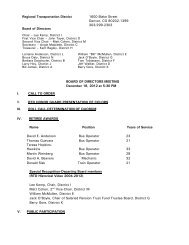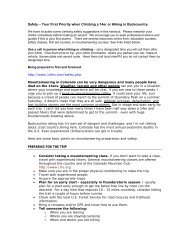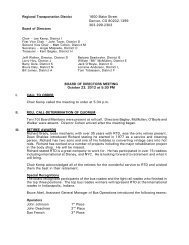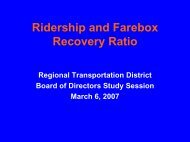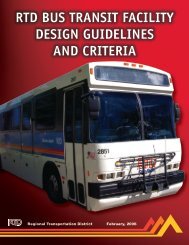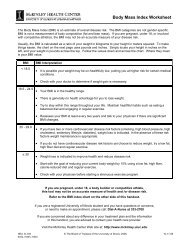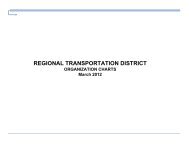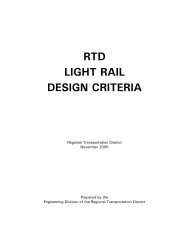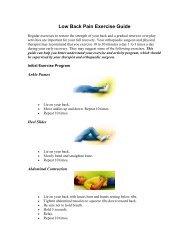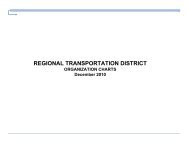Commuter Rail AC Electrification Load-Flow Simulation Report - RTD
Commuter Rail AC Electrification Load-Flow Simulation Report - RTD
Commuter Rail AC Electrification Load-Flow Simulation Report - RTD
You also want an ePaper? Increase the reach of your titles
YUMPU automatically turns print PDFs into web optimized ePapers that Google loves.
<strong>Commuter</strong> <strong>Rail</strong> <strong>AC</strong> <strong>Electrification</strong> <strong>Load</strong>-<strong>Flow</strong> <strong>Simulation</strong> <strong>Report</strong> Revision 1<br />
A corridor speed limit profile was developed in two stages. First, local speed restrictions were<br />
calculated for horizontal and vertical curves, following the <strong>RTD</strong> <strong>Commuter</strong> <strong>Rail</strong> Design Criteria,<br />
Section 4, Track Geometry and Trackwork, dated April, 2007, for “<strong>Commuter</strong> <strong>Rail</strong> Only.”<br />
Second, a corridor speed limit profile was developed that was less than or equal to the local<br />
restrictions, but smoothed speed limit transitions to remove unwarranted accelerations and<br />
decelerations that would waste traction energy and add to passenger discomfort without<br />
significantly reducing overall travel times.<br />
<strong>RTD</strong> Planning & Development Department memo, "Gold Line and East Corridor Operations<br />
Plans," dated September 4, 2008, defined an operating plan and schedule for 2030 service<br />
levels. Gold Line was assumed to need one size of trainset, cycling between DUS and Ward<br />
Rd with headway varying to meet projected service demand. FRSC assumed that the same<br />
service schedule would be used in 2015.<br />
In August 2008, <strong>RTD</strong> provided hourly peak passenger demand from a Denver region patronage<br />
forecast model. <strong>RTD</strong> is planning to adopt the light rail passenger load standards, as defined in<br />
the <strong>RTD</strong> Planning & Development Department memo, “Light <strong>Rail</strong> System <strong>Load</strong> Standards,”<br />
dated April 10, 2008, for the FasTracks <strong>Commuter</strong> <strong>Rail</strong> operations. The peak demand was<br />
combined with passenger loading standards to determine that Gold Line requires two-car trains<br />
in 2015 and 2030.<br />
North Metro<br />
The basic vertical and horizontal alignments were provided by the North Metro Corridor<br />
Managers on November 19, 2007. Plan and profiles were supplied as engineering drawings,<br />
developed and maintained by URS Corporation, the corridor civil design lead contractor. These<br />
drawings were electronically digitized to capture horizontal curves and vertical elevations by<br />
stationing along the track. This alignment correctly followed the Union Pacific <strong>Rail</strong> Road<br />
alignment from 72nd Avenue to 162nd Avenue.<br />
The North Metro Corridor Managers and URS Corporation updated the alignment data on May<br />
23, 2008 to change the alignment between DUS and 72nd Avenue. The new data followed the<br />
Burlington Northern Santa Fe alignment from DUS to the intersection of Brighton Blvd and York<br />
St at the northeast corner of the Riverside Cemetery, and then followed the URS “B3” alignment<br />
from here to 72nd Avenue. As before, the alignment was provided as engineering drawings<br />
which were electronically digitized to capture horizontal curves and vertical elevations.<br />
A corridor speed limit profile was developed in two stages. First, local speed restrictions were<br />
calculated for horizontal and vertical curves, following the <strong>RTD</strong> <strong>Commuter</strong> <strong>Rail</strong> Design Criteria,<br />
Section 4, Track Geometry and Trackwork, dated April, 2007, for “<strong>Commuter</strong> <strong>Rail</strong> Only.”<br />
Second, a corridor speed limit profile was developed that was less than or equal to the local<br />
restrictions, but smoothed speed limit transitions to remove unwarranted accelerations and<br />
decelerations that would waste traction energy and add to passenger discomfort without<br />
significantly reducing overall travel times. The maximum corridor speed limit was limited to 70<br />
mph in deference to corridor stack holder concerns over wayside noise and general corridor<br />
safety.<br />
<strong>RTD</strong> Planning & Development Department memo, "North Metro Corridor 2008 APE Service<br />
Plans – 2015 & 2030," dated May 20, 2008, defined an operating plan and schedule. North<br />
Metro trains were assumed to cycle between DUS and 162nd Ave with train size and headway<br />
varying to meet projected service demand.<br />
02/27/2009 FRSC Page 57 of 250




